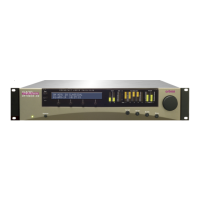OPTIMOD-AM DIGITAL OPERATION
3-11
the 15 ms delay of the digital radio processing chain because of less acoustic comb
filtering. (See step 8 on page 2-28 and step 9 on page 2-28.)
If the talent relies principally on headphones to determine
whether the station is on
the air, simple loss-of-carrier and loss-of-audio alarms should be added to the system
when the 9400’s monitor output is used. The 9400 can be interfaced to such alarms
through any of its eight GPI remote control inputs, cutting off the low-delay audio
to the talent’s phones when an audio or carrier failure occurs. (See Monitor Mute on
page 2-47.)
Monitor Rolloff Filter for the Analog AM Channel
The
response curve of the monitor system is as important as its quality. Because the
studio monitor typically has a flat response, and because OPTIMOD-AM's AM-
channel output is ordinarily significantly pre-emphasized, the sound that emerges
from the monitor will be shrill and unpleasant if the supplied Monitor Rolloff Filter
is not installed before the monitor amplifier.
The response of this filter can be jumpered to emulate an “ideal” NRSC radio or to
complement the frequency response of the HF equalizer with its HF
CURVE set to 0.
Because there are so few radios with anything approaching NRSC response (even in
NRSC countries), we believe that it is wiser to jumper the Monitor Rolloff Filter for
non-NRSC operation in almost all situations. If this 18dB/octave rolloff is used, the
response of this filter is approximately complementary to the frequency response of
the HF Equalizer with HF
CURVE set to 0. (See Figure 3-1 on page 3-33 and Figure 2-5
on page 2-6.). Because the filter shelves off at high frequencies (to match the re-
ceiver
equalization) instead of continuing to roll off like a real radio, the monitor
will sound somewhat brighter than a real radio and cannot be used to make final
subjective adjustments of OPTIMOD-AM setup controls. Nevertheless, it is suitable as
a reference for assessing quality, as it will clearly reveal distortion and other prob-
lems that may arise in the plant. Indeed, it will be somewhat more revealing than a
real radio.
Reference Radios for Adjusting the Analog AM Processing
However
, do not rely on your monitor alone for subjectively evaluating your air
sound. It is a good idea to develop a set of “reference radios” with which you are
familiar and which are similar to those used by a majority of your audience. Too of-
ten, just one radio (typically the Program Director or General Manager's car radio) is
used to evaluate air sound. Unless all of your listeners happen to have the same ra-
dio, this approach will not give an accurate indication of what your audience is hear-
ing.
Based on their high-frequency response, AM radios can be divided into three groups:
Group 1: Wideband AM stereo radios, typically with response that approxi-
mately follows the recommended NRSC “modified 75µs” de-emphasis to 5 kHz
or above. These are radios that conform to the NRSC/EIA's “AMAX” specifica-
tions and can bear the AMAX® logo.
Group 2: Radios with a response down 3dB at approximately 2 kHz, with a gen-
tle rolloff above that frequency. Because the rolloff is gentle, pre-emphasis can

